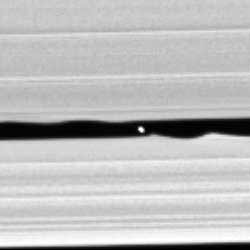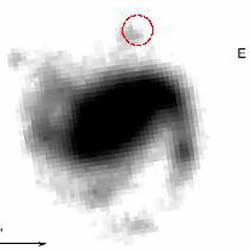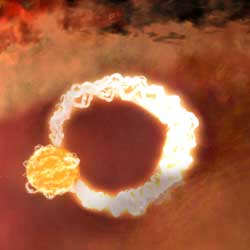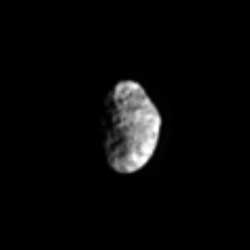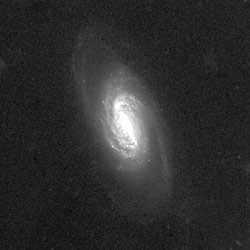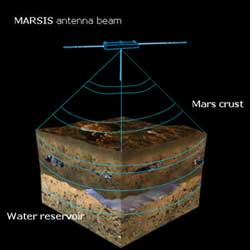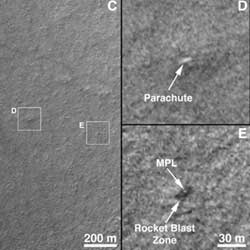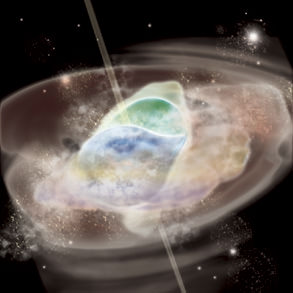
An artist’s impression of merging neutron stars, one of the theoretical progenitors of gamma-ray bursts. Image credit: NASA E/PO, Sonoma State University, Aurore Simonnet. Click to enlarge.
Gamma Ray bursters (GRBs) are almost a daily occurrence – so you’d think follow-up on such things would be routine by now – but that’s just not the case. Imagine a fire department having to respond to a new fire every day: they’d still have to pull on hats and heavy raincoats, slide down shiny metallic poles, and jump onto their fire engine as fast as possible.
And on Monday, May 9th, 2005 there were two fires; one reported earlier in the day by NASA’s HETE-2, and then another by its even more sophisticated associate SWIFT.
So even as we were working on a previous story for Universe Today readers about a dark Gamma Ray Burster detected by HETE-2 in August 2002, two new bursts occurred overhead. Both events sounded the alarm and astronomers worldwide scrambled to capture the rapidly diminishing optical afterglow (OAs) that might help explain one of the deepest mysteries in the Universe: how can so much energy be packed into those tiny, massless photons?
GRB events themselves are of two types. Some are “hard and fast” while others are “soft and slow”. When a “hard-fast” event occurs, astronomical fire fighters have to work quickly.
It all begins when HETE-2 or SWIFT detects an outburst from their lonely perches in low Earth orbit. Once a burst is detected, instruments aboard the craft swing around to make a determination of just where in space that event has occurred and capture whatever lingering x-ray data may still be available. Here SWIFT has the advantage over HETE-2 due to its smaller “error circle” – the satellite’s best guess as to the location of the event in the heavens. Data related to location, burst strength, and duration is then beamed to NASA instrument teams on Earth where the data is integrated and advisories are published to enlist available astronomers and instruments.
All this is comparable to an “all points bulletin” going out so astronomers anywhere can scramble to capture what is now the rapidly diminishing afterglow of the main event. Typically only small instruments associated with major observatories respond first, since larger instruments are scheduled months in advance for other projects. You’ll never see the mighty Hubble Space Telescope swing around for one of these events.
Even as available scopes turn to the sky, astronomers look for detailed survey charts of the region associated with the error circle. Why? Because images and data may already be available to simplify afterglow identification along with baseline spectra, and recessionary distances of host galaxies to assist their analysis.
As time passes, larger and larger instruments are made available for use. This is essential since dark GRBs fade quickly and more and more optical depth is needed to pick up the trail. In the case of GRB020819 detected by HETE-2 in 2002 not even the 10-meter Keck ESI instrument (capturing 26th magnitude light) was able to image an afterglow even though it swung around within 15 days of the initial high energy burst. But with SWIFT’s rapid response and tighter error circles its now becoming possible to catch a dark GRB in the act of disappearing for good.
Of the two GRB events of the day, GRB050509B is most promising because its optical light afterglow is relatively dim (fainter than the 20th magnitude) and galaxy is relatively bright (the 15th). And it is because roughly 1 in 10 GRBs are optically impoverished that makes them specially interesting to astrophysicists. Basically current models used to explain dark GRB events predict that a broad range of photon-energy levels should be seen to accompany any gamma-ray outburst. The fact that some GRBs don’t happen to map well against theory is troublesome, and therein lies the itch behind GRB020819’s (and now GRB050509B’s) scratch.
One theory of GRBs is that gamma rays somehow “muscle their way” through intervening matter in space while optical light – the “afterglow” of such an event – does not. This optical extinction scenario has yet to be demonstrated and several dark GRBs show no sign of the kind of massive clouds of intervening matter needed to support it.
Meanwhile there are three theories of the fireball-shock type postulated by astrophysicists to account for all rapidly diminishing short-time scale GRBs. The fireball scenario typically involves an explosion that hurls extremely hot gases at exceedingly high speeds into space after some kind of a cataclysmic event. These gases then interact with other material already present in the interstellar medium (ISM) or material previously ejected into space by the same object at lower velocities. One theory postulates a “relativistic jet” of hot gases penetrating either a stratified “onion” of other slower moving gases or a simple homogeneously filled-“bubble” of gases. The others assume either a rapidly expanding sphere of hot gases into the same type “bubble” or “onion”.
According to an international team of astronomers, data analyzed across the EM spectrum from GRB020819 supports the expanding sphere into homogeneous medium fireball-shock model. Those findings have been documented in a paper entitled “The Radio Afterglow and Host Galaxy of the Dark GRB020819” published May 2, 2005. The related Universe Today article is an online companion to this article entitled “Shedding Light on Dark Gamma Ray Bursters“.
Meanwhile – at this very moment – astronomical “firefighters and fire marshals” are gathering data associated with SWIFT’s detection of GRB 050509B. This process may continue in one form or another for as long as six months. Several years hence a team of investigators – such as that associated with GRB020819 – may attempt to make sense of how a little understood paroxysm of matter and energy occuring some 2.5 billion years ago in the direction of the springtime constellation Coma Berenices could ever have happened in the first place.
To make all this possible numerous and ever larger “eyes on the skies” will have to collect and focus radio, near-infrared, optical, and near-ultraviolet light. All of that information will be sifted through with infinite patience in an effort to forensically determine not “who done it” but “what”.
Written by Jeff Barbour

